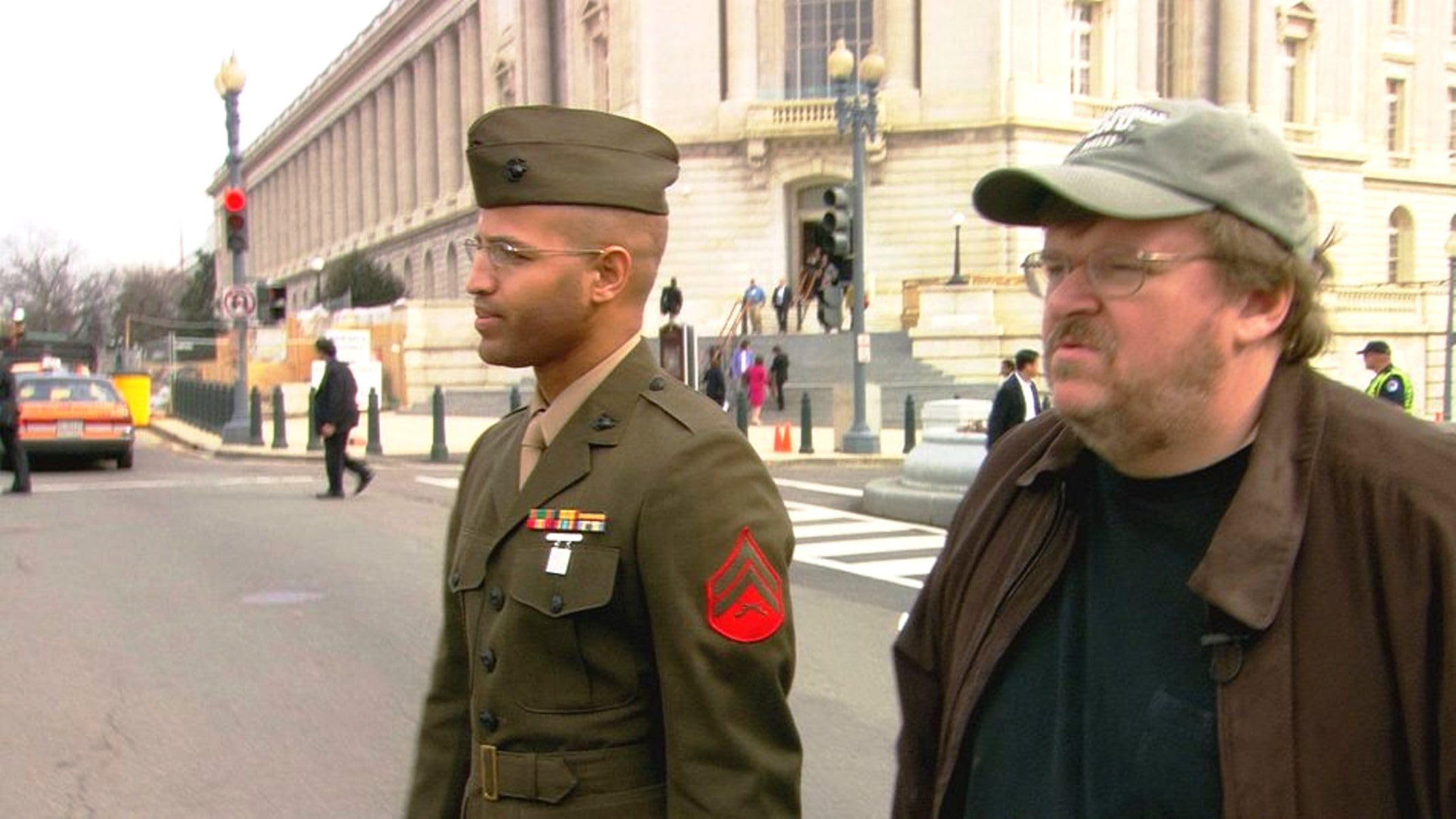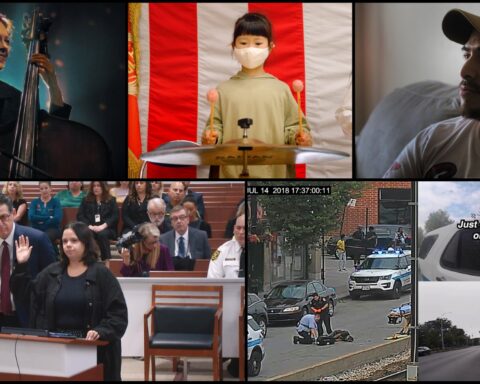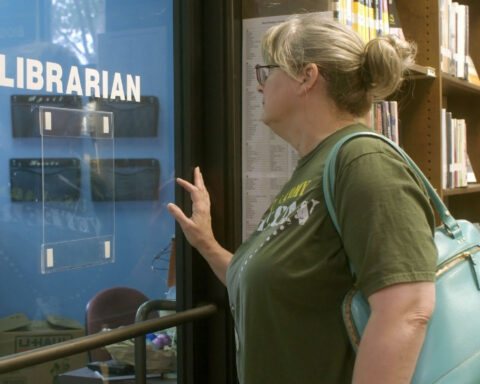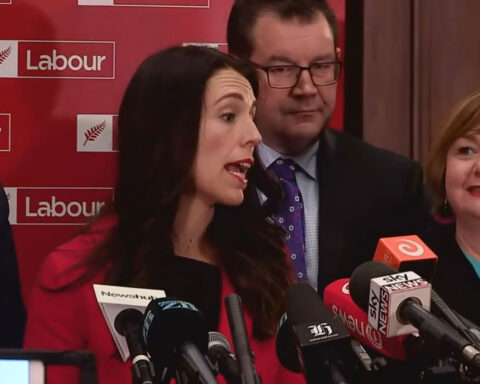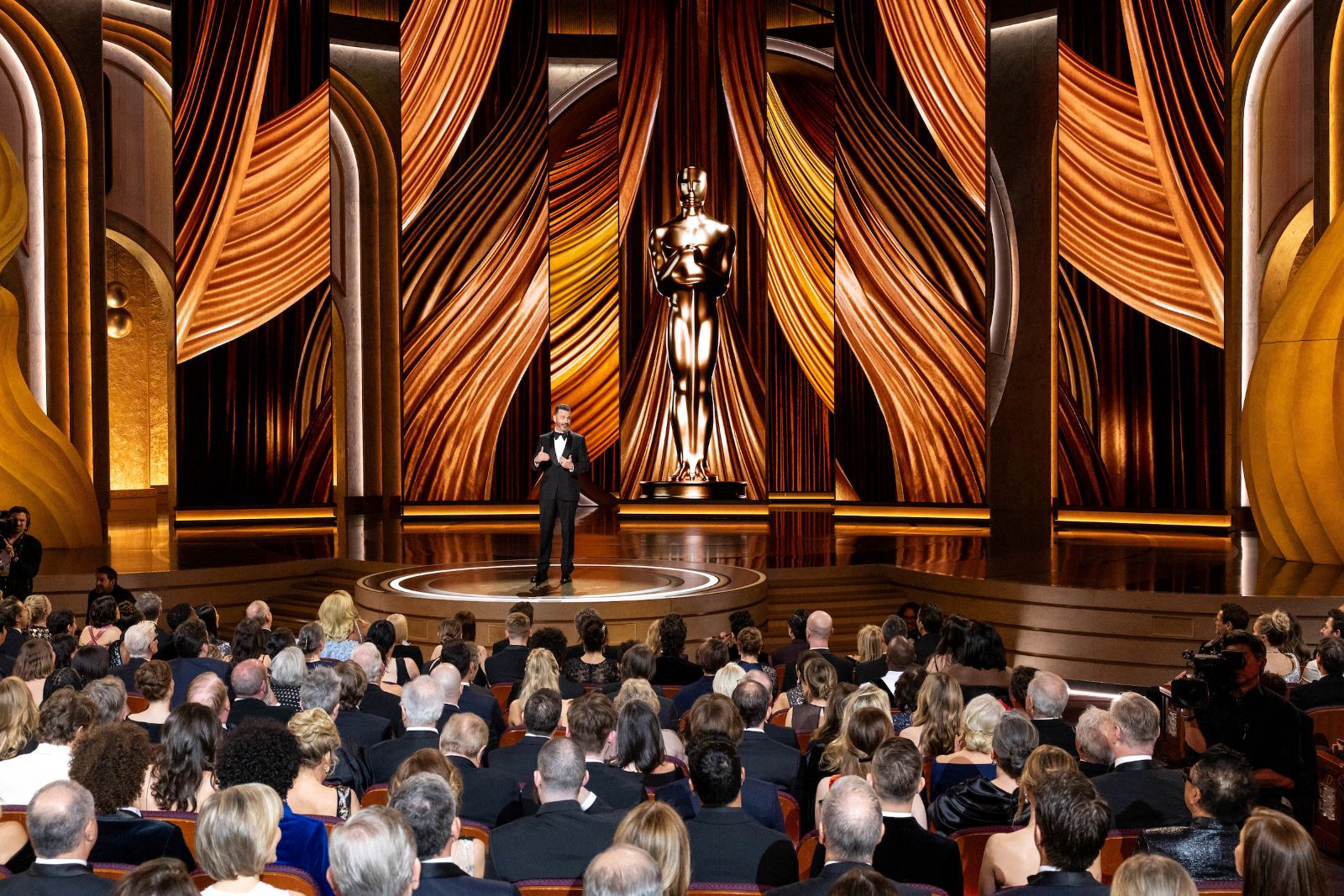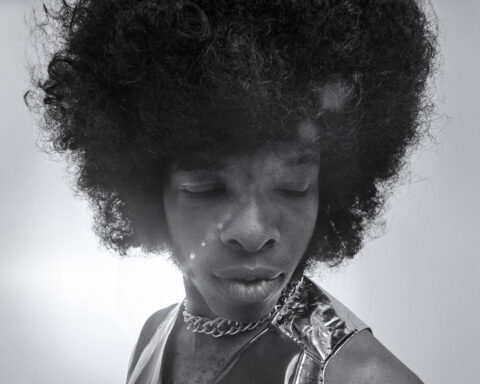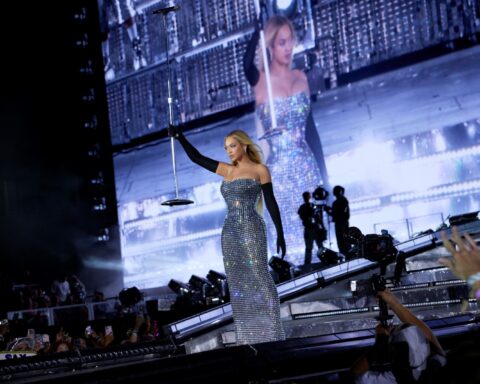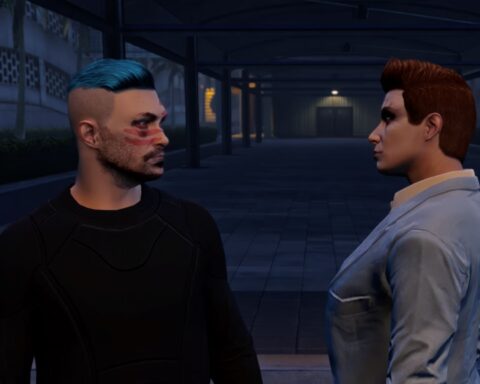
On the evening of March 23, 2003, during Hollywood’s big night, a dapper Michael Moore strolled onto the red-carpet of the Kodak (now Dolby) Theatre. Wearing his smoking tuxedo, Moore had low expectations on Oscar night. After winning the Film Independent Spirit Award for Best Documentary Feature the night prior, Moore kept a level headed view of his chances. His controversial Bowling for Columbine was up against tough competition, with films such as Spellbound and Winged Migration in the running. Moore infamously never wrote an Oscar speech. The last box-office smash to win an Academy Award for Best Documentary Feature was Michael Wadleigh’s Woodstock (1970). During the commercial break, Moore approached his fellow nominees. The documentarian requested their presence, in the case that Bowling for Columbine won the coveted prize.
As Diane Lane shouted the director’s name after opening her Oscar-branded envelope, Moore’s win finally broke the 33-year gap. Academy darlings Daniel Day-Lewis, Meryl Streep, and Cameron Diaz applauded his victory. The other nominees in the category followed suit. Moore’s entourage of non-fiction filmmakers stood in solidarity. A global audience was watching, with over 33 million viewers tuning into the telecast. Days before, America invaded Iraq. The first patriotic images of the war effort had just aired. The subject of the war was a taboo topic. Nobody dared to publicly criticize the political polarization…except for Michael Moore, who didn’t accept that the Oscar show offered an escape from reality.
In under 60 seconds, the audience’s response to Moore’s stage-presence went from unanimous applause to collective disdain. With gusto, Moore began his televised diatribe: “We live in a time where we have fictitious election results that elect a fictitious president. We live in a time where we have a man sending us to war for fictitious reasons.” In a reaction that echoed America’s division, the attendees unabashedly reacted to Moore’s indictment of blinded nationalism. Boos and groans clashed with simultaneous applause and whistles. Within the chaos, the broadcast captured Martin Scorsese’s support of Moore’s speech. The world-famous director began to clap, before the cameras abruptly cut to the uneasy reaction of the crowd. The Bowling for Columbine team was orchestrated off-stage, with predictable musical accompaniment drowning Moore’s final words: “Any time you’ve the Pope and the Dixie Chicks against ya, your time is up!”
The Inception of Fahrenheit 9/11
Moore’s unfiltered passion from his Oscar speech stemmed from his year-long research on the Bush administration. With his next project entitled Fahrenheit 9/11, Moore was specifically seeking answers in regard to the Bush administration and its relationship with the Bin Laden estate in the aftermath of the 9/11 terrorist attacks. “It asks a number of questions that I don’t have the answers to yet, but which I intend to find out,” commented Moore, after his sensational Oscar speech. In the months following his televised screed, Moore was harassed nearly every day on the street. People spat at him, while other upset Americans insulted Moore with verbal vulgarities. Some even threatened physical violence.
However, as time went along, the public consciousness became weary of Bush’s war. “By the end of the summer, for what I said on the Oscar stage, I went from pariah to prophet,” expressed Moore. During the senseless invasion, where thousands of young Americans were lined up to fight against an unknown entity, Moore and his production on Fahrenheit 9/11 faced a different kind of war. Mel Gibson’s Icon productions initially pledged eight figures upfront, but dropped out of the project in the weeks following his Oscar speech. Many industry delegates speculated that the sudden drop in production dollars was associated with Moore’s political affiliations. The proposed film was a radical political weapon that nobody wanted to detonate, or even touch in Hollywood.
The Mouse in the Room
In the end, Harvey Weinstein’s Miramax provided bridge financing for the film. Wild Bunch (known now as Goodfellas) handled the sales.
However, there was constant behind the scenes pandemonium with Miramax. This was often the case after June, 1993, when Disney purchased Miramax, relieving Weinstein’s accumulated debt of $40,000,000 USD, and offering additional financing for future projects. The acquisition was a resounding success, with films such as The Piano, Pulp Fiction, Life Is Beautiful, The English Patient, Good Will Hunting, and Shakespeare in Love bringing critical acclaim and awards recognition to the small company. (The legacy was ultimately tarred by revelations of Weinstein’s rampant history of sexual assault and misconduct decades later.)
Miramax remained indebted to Disney CEO’s Michael Eisner. Precisely ten years later, Disney threatened Miramax over the distribution and funding of Fahrenheit 9/11. According to Moore’s agent Ari Emanuel, Eisner expressed concern that the project would anger the President’s brother Jeb Bush. At the time, Jeb Bush was the governor of Florida.
Due to the politicized nature of the project, Eisner speculated that the film could endanger tax breaks for Disney’s various theme parks, hotels, and other business ventures in the state. Disney executives denied Emanuel’s accusations, elaborating that the company caters to all political demographics and families, but privately they believed Moore’s film was partisan against the Bush administration.
Miraculously, production quietly continued. Moore was even able to commission various freelancers who were able to go to Iraq and bring back footage of the on-going invasion. Miramax was eventually forced to abandon distribution with the Weinsteins acquiring the rights to the film. (It was later distributed in the USA by Lions Gate and IFC Films.)
How Michael Moore Makes Us Think
Twenty years onward, Moore’s incendiary indictment continues to inspire, even with the extensive production hurdles. Fahrenheit 9/11 still resonates as it follows George W. Bush’s secretive web of business relationships. Moore acquires classified reports, contrasting and comparing marked-out passages from military records and other paraphernalia. (Moore notably created a “war room” to document the film’s information. Chris Lehane and Mark Fabiani, both veteran advisors to Bill Clinton and Al Gore, were assigned to compile a 400-page bible of documents.) In the process, Fahrenheit 9/11 excavates a plethora of confounding factoids. Moore describes the ineptitude of the Bush administration in the days following 9/11. In one of the film’s most essential interviews, former FBI agent Jack Cloonan elaborates on the fallacies of the investigation. Instead of questioning members of the Bin Laden family, the administration allowed associates to fly on September 13, 2001 without a proper investigation.
The capitalist greed of the Bush administration is also thoroughly investigated. During an alarming sequence, Moore focuses on Bush’s unlikely relationship with James Bath, who was hired by members of the Bin Laden family to invest in local American businesses. Bath would use the Bin Laden funds to finance some of Bush’s extravagant business ventures. Moore also reveals Bush’s involvement with the Carlyle Group, a private equity company which received investments from the Bin Laden family. The documentary includes interviews with American author Craig Unger. The acclaimed writer wrote the New York Times best-seller House of Bush, House of Saud, which backs Moore’s claims of institutional malpractice. Through juxtaposition, Moore interrogates governmental authority with extensive research.
How Michael Moore Makes Us Laugh
Moore further implements juxtaposition effectively with his signature comedic touch. In one witty montage, Moore overlays REM’s “Shiny Happy People” with footage of the Bush family congregating with their Saudi investors. Sardonic transitions accompany the cheerful tune; punctuating the outlandish business relationships. Other iconic scenes include Moore’s interviews with a peace group, a quaint non-violent community based in Fresno, which was infiltrated by a local deputy in the wake of the Patriot Act. Signed into law by the United States Congress, the act was the Bush administration’s sweeping (and deeply troubling) anti-terrorism policy, which was quickly enforced in the aftermath of 9/11.
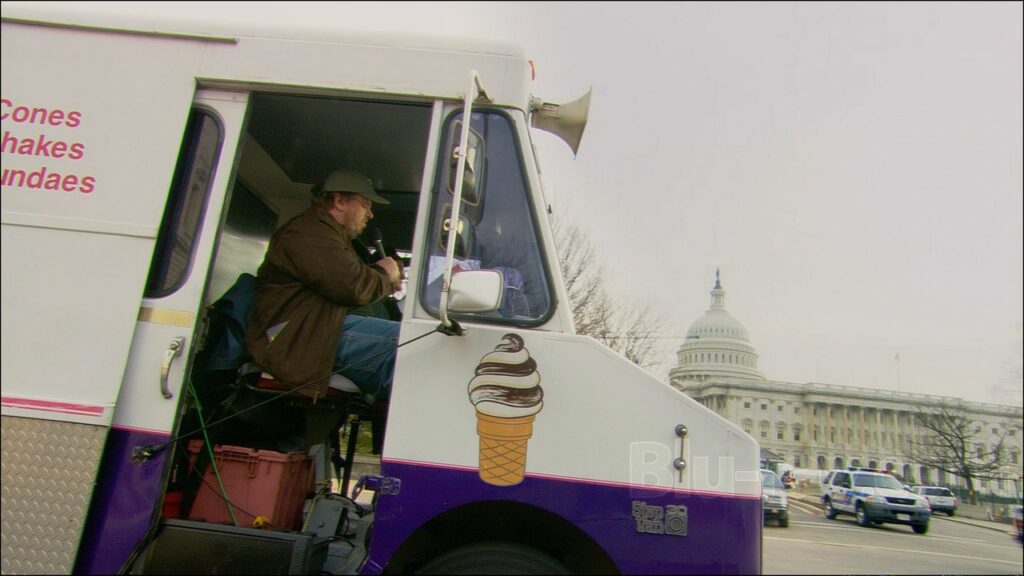
In another scene, Moore borrows an ice cream truck, driving in front of the Capitol Building while reading the Patriot Act through the truck’s loudspeaker. The form enhances the critique when Moore repurposes footage for comedic pathos. Holiday season cheer is infiltrated by hysterical headlines and other paranoiac broadcasts. Moore juxtaposes and deconstructs media influence through montage. Absurd advertisements promoting affordable safe-houses and easy-to-use parachutes enforce Fahrenheit 9/11’s anti-capitalist commentary. Fear dictates the flow of mass-profit in Moore’s documentary.
How Michael Moore Makes Us Cry
While the comedic elements accentuate the severity of the political claims, Fahrenheit 9/11 balances Moore’s iconoclastic humour with the powerful unravelling of national trauma that enabled many of the Bush administration’s atrocities. The film’s title card sequence features footage of some of America’s most notorious leaders preparing for their close-ups: Dick Cheney, Condoleezza Rice and Paul Wolfowitz all make appearances in the montage. Makeup is gently applied to their patriotic visages as microphones capture their banter. The feed is accompanied by an unsettling string accompaniment. Before they air, the Republican representatives control their self-image for the network. The essence of the mournful montage enforces Moore’s contemplative thesis. The images are inherently artificial with footage emblematic of dangerous propaganda.
Moore counteracts his sequence with a chilling minute of darkness. We hear the collapse of the Twin Towers, as explosions, sirens, and shuffling feet consume the soundscape. Moore fades into a post-9/11 world with sounds and accompanying images of people. Crowds of frightened civilians gaze up to the sky, disturbed by the unspeakable. The destruction of the Twin Towers is never shown, but rather heard. The empathetic presentation ignites the start of a new America: a nation shattered at the foundation of the World Trade Centre. Compounded by inequalities faced by the working class, a climate of political divisiveness continues to grow to this day.
Moore generates empathy with the working class within the second half of Fahrenheit 9/11. Highlighting the unemployment epidemic in his hometown of Flint, Michigan, the documentary questions the U.S military’s role in capitalizing upon disenfranchised communities. Moore captures the recruiting process in vivid detail. The outgoing demeanour of the national guard is reminiscent of a door-to-door salesman, as they attempt to finalize their big sale. Within the investigation, we learn about Flint resident Lila Lipscomb. Moore intimately documents Lipscomb’s values and perceptions of the war, as we learn more about her devastating past. In one of the film’s most heart-wrenching scenes, Lipscomb reads her son’s final letter from Iraq. “I am so furious right now, mama,” she reads, with tears in her eyes. Lipscomb is just one of thousands of Americans who are considered as the backbone of her country, betrayed by her nation’s profiteering of natural commodities.
Fahrenheit 9/11 also demonstrates the Iraqi perspective of the invasion through commissioned observational footage. In a peaceful montage, Moore captures their quotidian routines. Couples dine in lavish restaurants. The sun shines bright. A group of children fly a kite on a beautiful spring afternoon. In the blink of an eye, America sets the sovereign nation ablaze. Moore emphasizes the similarities between Western and Middle Eastern societies. The documentary includes horrific images of the bloodshed to enforce the humanitarian rhetoric. “What’s this baby’s crime?” shouts a civilian, while raising the bloodied body of a massacred child in his hands.
Moore implements ironic juxtaposition, weaponizing The Bloodhound Gang’s “The Roof Is on Fire” with merciless images of imperialist sacrilege. The same editorial method carries a different emotional response. Moore’s montage never strays away from the callousness of war. The rotting bodies of innocent Iraqi civilians are cut with the patriotic beat. More relevantly, Moore mentions that the acts of terrorism perpetrated by the American state were conducted by the country’s directionless youth. Fear, lies, and racist ideology blinded the impoverished soldiers in their acts of inhumanity. “Immoral behaviour breeds immoral behaviour” intones Moore in thoughtful narration.
A Bigger Splash on the Croisette
When the film was selected to compete at the 2004 Cannes Film Festival, Moore arrived at the Palais des Festivals with a bombshell. Up until the premiere of the film, the world was only familiar with the still photographs from the Abu Ghraib prison. “You saw this morning the first footage of abuse and humiliation of these Iraqi detainees,” stated Moore at the Cannes press conference for Fahrenheit 9/11. “This occurred in the field. This occurred outside the prison walls. You were the first to see that today. That is disgraceful.” Moore was initially criticized for not releasing the footage in his possession earlier. However, Moore claimed that he showed the footage to a New York Times reporter, who did nothing with the material. “If the freelancers I was using were able to find what they found in the field in Iraq, with our limited resources, you have to ask the question: ‘Why haven’t we seen this?’” pondered Moore in the same conference.
When the film screened at the Auditorium Louis Lumière, it received a 20-minute standing ovation. The applause and support behind the film was immense, achieving the second longest ovation in the festival’s history. A few days later, Fahrenheit 9/11 won the converted Palme d’Or–the first documentary to win the prize since Jacques Cousteau and Louis Malle’s The Silent World (1956).
Jury president Quentin Tarantino and his jury received harsh criticism for their selection. The jury was accused of favouring politics over filmmaking. Tarantino adamantly defended Fahrenheit. In the awards press conference, stating, “This film is made of images. When a U.S soldier is shown with a captive whose head is in a hood, that is not a pretty picture, but it is a powerful image.”
Jury member Tilda Swinton concurred, stating the documentary validates cinema. “The things that Michael Moore is saying in this film cannot be said in TV media in the United States at the moment,” she proclaimed. Haitian-born novelist and jury member Edwidge Danticat agreed, pointing out that the film “gives voice to people who are voiceless.”
The Release of Fahrenheit
 After winning the Palme d’Or, the Weinsteins established the Fellowship Adventure Group for the film’s distribution. After paying back Disney for the film’s production costs, the documentary was slated for a June 25 release. In the days leading up to the opening weekend, White House Communications director Dan Bartlett claimed that the film was “so outrageously false, it’s not even worth commenting on.” Moore also faced opposition from conservative groups. One party called for an investigation regarding the film’s advertising campaign. Under the federal campaign finance law, the bill prohibits the broadcasting and identification of a presidential candidate 30 days before the party’s nominating convention and 60 days before the general election.
After winning the Palme d’Or, the Weinsteins established the Fellowship Adventure Group for the film’s distribution. After paying back Disney for the film’s production costs, the documentary was slated for a June 25 release. In the days leading up to the opening weekend, White House Communications director Dan Bartlett claimed that the film was “so outrageously false, it’s not even worth commenting on.” Moore also faced opposition from conservative groups. One party called for an investigation regarding the film’s advertising campaign. Under the federal campaign finance law, the bill prohibits the broadcasting and identification of a presidential candidate 30 days before the party’s nominating convention and 60 days before the general election.
The Fellowship Adventure Group lost their battle to lower the MPAA rating from R to a PG-13 classification. It would have allowed the film to be shown to a wider and younger audience. Rona Shamoon, a lawyer from Scarsdale, called Moviefone’s 777-film phone-line during the film’s release month. She was told through the phone-line that Fahrenheit 9/11 was rated NC-17. Shamoon theorized that someone was trying to “keep people from seeing this film.”
Against all odds, the film opened to sold out shows, playing on more than two screens in select multiplexes. There were even midnight screenings for the documentary! Fahrenheit 9/11 was a David versus Goliath phenomenon, earning $23,920,637 USD domestically on its opening weekend against Hollywood summer movies like The Notebook and White Chicks. Certain cinemas such as the Grand Lake Theatre didn’t enforce the R-rating, calling the decision politically motivated. Moore’s documentary took the nation by storm, evoking a reaction that echoed the same response from his Oscar speech with a chorus of boos and whistles culminating from both sides of the political divide. Until recently, Fahrenheit 9/11 held the domestic box office record for the highest grossing documentary of all time; it was surpassed only by Taylor Swift’s concert doc The Eras Tour (2023).
Although happy with the financial success, Moore was motivated politically to create a wider outreach for the film. Moore encouraged the American people to watch his film before the presidential election. Sacrificing eligibility for Oscar consideration in the documentary category to facilitate a broadcast date, speculation grew if Fahrenheit 9/11 could be the first documentary nominated for Best Picture, and public interest kept momentum going as Fahrenheit 9/11 was released onto DVD and VHS on October 5th, 2004. Over two million copies and rentals were sold on the first day of its release. Moore once claimed, “If you make the right kind of movie, people can leave (the theatre) and not stop talking about it for hours or days to come. On that level, I think it can have a huge impact.”
Despite Moore’s commendable efforts, Bush was re-elected on November 2 for his second term.
In 2018, Moore would try to recreate the same lightning in the bottle response with his spiritual successor Fahrenheit 11/9. The film specifically tackled the 2016 presidential election, while contrasting Trump’s fascist governmental structures. Unlike the first film in his unconventional franchise, the sequel was the lowest grosser of Moore’s films in wide release with $6.4 million.
Why Do We Look Back?
Twenty-years onward, Fahrenheit 9/11 still retains its political urgency. The grave events recounted in the documentary still woefully repeat themselves to this day. Whereas Moore demonstrated the Saudi Arabian relationship with the Bush estate, organizations such as the AIPAC (American Israel Public Affairs Committee) have illegally influenced American congressmen through shady business deals. Promises of Tel Aviv vacations and other hedonistic benefits ensure governmental impunity for the Israeli state.
Today, the systemic inaction regarding the Palestinian genocide is influenced by the Gaza Strip’s rich oil foundation. Just as in Fahrenheit 9/11, the current administration’s proposed exploitation of Palestinian resources is reminiscent of the Afghanistan/Caspian Sea oil pipeline, which is a billion-dollar industry. Going beyond the scope of the documentary, Bush’s Hague Invasion Clause is reminiscent of the recent sanctioning by the ICC (International Criminal Court). American tax payers continue to fund the murder of innocent families.
The painful images of innocent Iraqis brought to the forefront in Moore’s revelatory documentary continue to seethe. Dead children, tortured civilians, bombed refugee camps, and other oppressive acts of terror have been largely ignored by our news organizations. Even with social media, verifiable images of war crimes are scarcely found. Censorship of Palestinian voices reigns supreme, as Hollywood has also blacklisted world-renowned stars. Melissa Barrera, one of the leading performers of the Scream franchise, was fired by Spyglass Productions for her criticisms of the Israeli state. Outspoken advocates like Susan Sarandon have been dropped by their agencies. Filmmakers in Canada and elsewhere temper their political expressions with fear that saying the wrong thing could compromise their financing.
At the end of the film, Moore pensively states, “A hierarchical society is only possible on the basis of poverty and ignorance.” His nightmarish account has evolved into a mirror of our current society. An influx of misinformation still commands the public’s attention, making audiences question everything from images on social media feeds to reports from venerable media institutions.We continue to live in fictitious times. Fahrenheit 10/7 is just around the corner.




